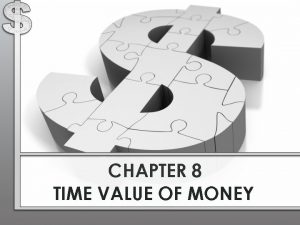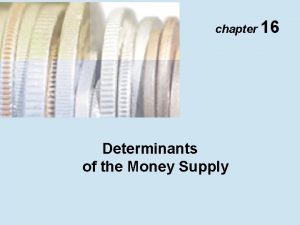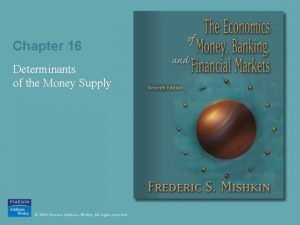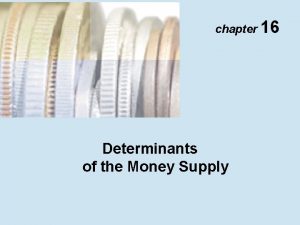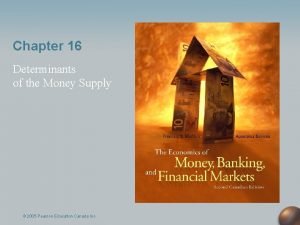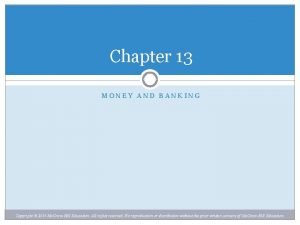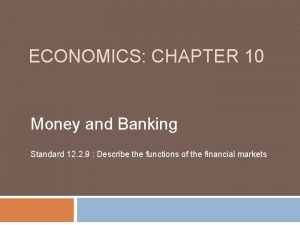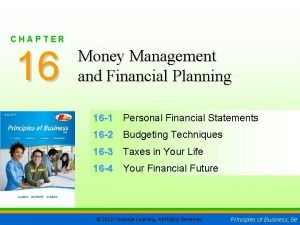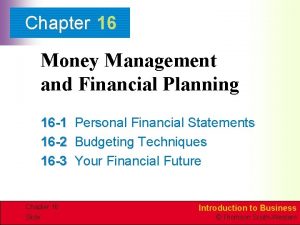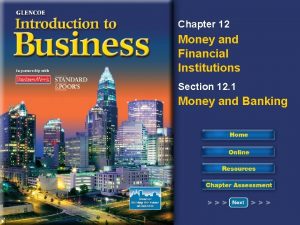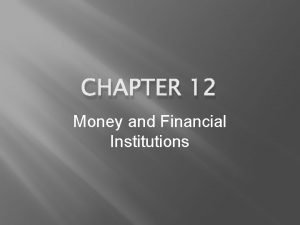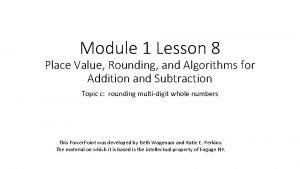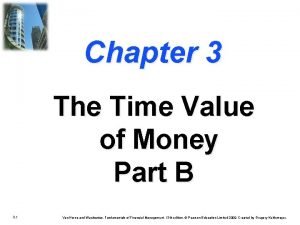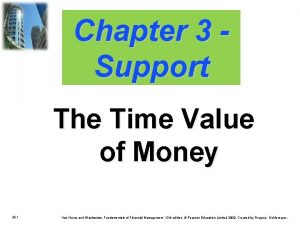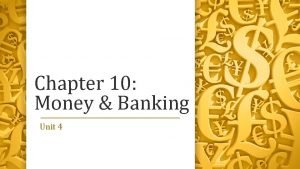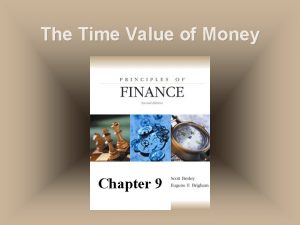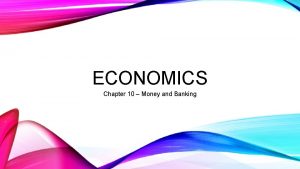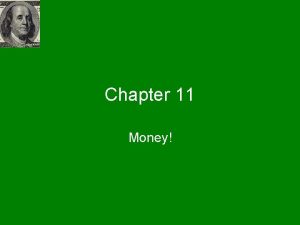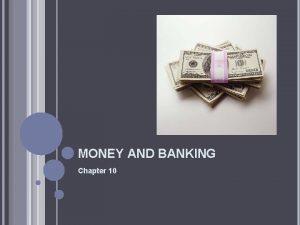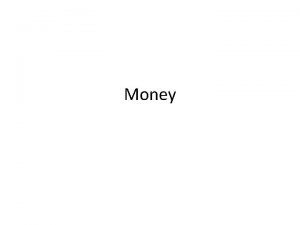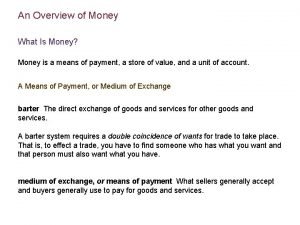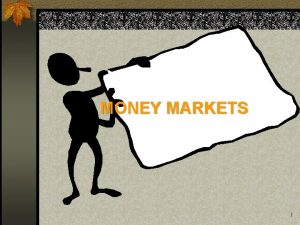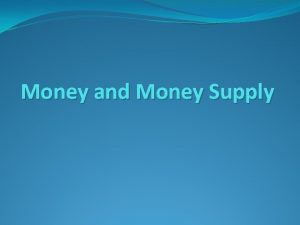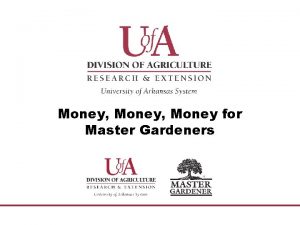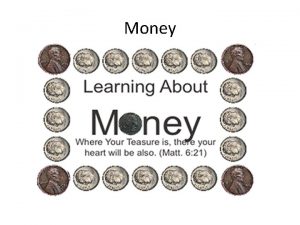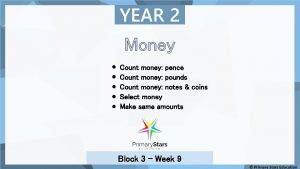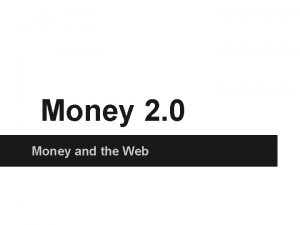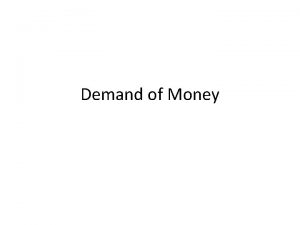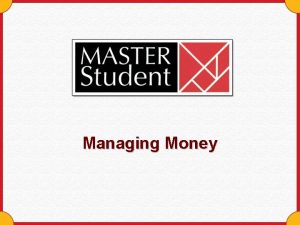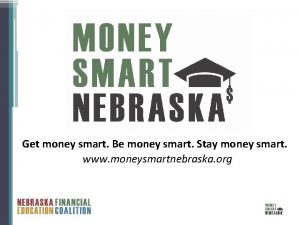Money Chapter 10 What is money n Money























- Slides: 23

Money Chapter 10

What is money? n Money is anything that serves as n a medium of exchange n a unit of account and, n a store of value.

What is money? (cont. ) n Money as a Medium of Exchange: n n Money as a Unit of Account: n n A medium of exchange is anything that is used to determine value during the exchange of goods and services… A unit of account is a means for comparing the values of goods and services… Money as a Store of Value: n A store of value is something that keeps its value if it is stored rather than used…

Characteristics of Money n The coins and paper bills used as money in society are called currency. A currency must meet the following characteristics: n Durability n Objects used as money must withstand physical wear and tear n Portability n People need to be able to take money with them as they go about their business n Divisibility n To be useful, money must be easily divided into smaller denominations, or units of value

Characteristics of Money (cont. ) n Uniformity n n Limited Supply n n Any two units of money must be uniform, that is, the same, in terms of what they will buy Money must be available only in limited quantities Acceptability n Everyone must be able to exchange the money for goods and services

Categories of Money n Commodity Money n n Representative Money n n Commodity money consists of objects that have value in themselves Representative money has value because the holder can exchange it for something else of value Fiat Money n Fiat money, also called “legal tender, ” has value because the government decreed that is an

Crash Course n https: //www. youtube. com/watch? v=Dugn 5 1 K_6 WA&index=11&list=PL 8 d. Puua. Lj. Xt. PN Zwz 5_o_5 uir. J 8 g. QXnh. EO

Quick Review 1. Two units of the same type of money must be the same in terms of what they will buy, that is, they must be (a) divisible. (b) portable. (c) acceptable. (d) uniform. 2. What is the source of fiat money’s value? (a) it represents the value of another item (b) government decree (c) presidential pardon (d) it is equal to the value of the stock market

Money Supply n The money supply is all the money available in the United States economy…

Liquidity is about how big the trade-off is between the speed of the sale and the price it can be sold for. n Money, or cash, is the most liquid asset, because it can be "sold" for goods and services instantly with no loss of value. n

Measuring Money Supply n M 1 n n M 1 consists of assets that have liquidity, or the ability to be used as, or easily converted into, cash. Components of M 1 include all currency, traveler’s checks, and demand deposits. Demand deposits are the money in checking accounts. M 2 n n M 2 consists of all of the assets in M 1, plus deposits in savings accounts and money market mutual funds. A money market mutual fund is a fund that pools money from small investors to purchase government or corporate bonds.


Why do we put $$$ in banks? n Banks perform many functions and offer a wide range of services to consumers: n Storing Money n n Credit Cards n n Banks provide a safe, convenient place for people to store their money. Banks issue credit cards — cards entitling their holder to buy goods and services based on each holder's promise to pay. Saving Money n Four of the most common options banks offer for saving money are: n n n 2. Checking Accounts 4. Certificates of Deposit (CDs) Loans n n 1. Savings Accounts 3. Money Market Accounts By making loans, banks help new businesses get started, and they help established businesses grow. Mortgages

How banks earn money… n The largest source of income for banks is the interest they receive from customers who have taken loans n Interest is the price paid for the use of borrowed money (how much it costs to borrow)

How Banks Make a Profit Money leaves bank Interest and withdrawals to customers Money enters bank Deposits from customers Interest from borrowers BANK Fees for services Bank retains required reserves Money loaned to borrowers: • business loans • home mortgages • personal loans Bank’s cost of doing business: • salaries • taxes • other costs

n What are the 3 purposes money serves? n What holds the most liquidity? What is included in M 1? What distinguishes M 1 from M 2?

Types of “Banks” n n n Commercial Banks n Commercial banks offer checking services, accept deposits, and make loans. Savings and Loan Associations n Savings and Loan Associations were originally chartered to lend money for home-building in the mid 1800 s. Savings Banks n Savings banks traditionally served people who made smaller deposits and transactions than commercial banks wished to handle. Credit Unions n Credit unions are cooperative lending associations for particular groups, usually employees of a specific firm or government agency. Finance Companies

Quick Review 1. The money supply of the United States is made up of which of the following? (a) M 1 (b) M 1 and parts of M 2 (c) all the money available in the economy (d) all the money available in the economy plus money that the country could borrow 2. Why are funds in checking accounts called demand deposits? (a) they are available whenever the depositor demands them by writing a check (b) they are not liquid (c) they are usually in great demand (d) they are held without interest by the bank

Where does your dollar get its value? n https: //www. youtube. com/watch? v=XNu 5 p p. FZb. Ho

Banks n https: //www. youtube. com/watch? v=f. TTGA La. RZoc

Cryptocurrency n Actively participate in the discussion n If we are off topic or are not engaging in this we will stop and continue working on notes

Cryptocurrencies n Bitcoin Explained n https: //www. youtube. com/watch? v=s 4 g 1 XFU 8 Gto

n Instructions After reading the article talk with the person next to you and discuss the following questions. n What are the positives and negatives Bitcoin has when acting as money? (medium of exchange, unit of account, store of value) What characteristics of currency does it have? n What category of money would this fall into? n How liquid is Bitcoin (M 1, M 2, M 3)? Why? n Do Bitcoin and other cryptocurrencies have a future as money? Explain your position. Be prepared to support it. n
 Money money money team
Money money money team Gatsby historical background
Gatsby historical background Money smart money match
Money smart money match Money on money multiple
Money on money multiple The great gatsby historical background
The great gatsby historical background Context of the great gatsby
Context of the great gatsby Chapter 8 time value of money answer key
Chapter 8 time value of money answer key Velocity formula econ
Velocity formula econ Chapter 16 determinants of the money supply
Chapter 16 determinants of the money supply Chapter 16 determinants of the money supply
Chapter 16 determinants of the money supply Chapter 16 determinants of the money supply
Chapter 16 determinants of the money supply Simple deposit multiplier
Simple deposit multiplier Chapter 13 money and the banking system answers
Chapter 13 money and the banking system answers Chapter 10 money and banking
Chapter 10 money and banking Chapter 16 money management and financial planning
Chapter 16 money management and financial planning What are some characteristics of a wise money manager
What are some characteristics of a wise money manager Chapter 12 money and financial institutions
Chapter 12 money and financial institutions Chapter 12 money and financial institutions
Chapter 12 money and financial institutions Lesson 8 use place value to round numbers answer key
Lesson 8 use place value to round numbers answer key Firmilate
Firmilate Chapter 3 time value of money problem solutions
Chapter 3 time value of money problem solutions Chapter 10 money and banking worksheet
Chapter 10 money and banking worksheet Chapter 2 time value of money solutions
Chapter 2 time value of money solutions What is a fiat currency
What is a fiat currency






